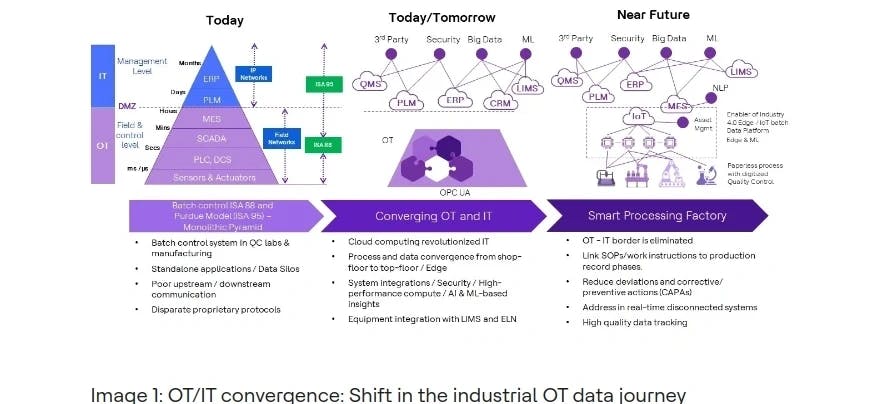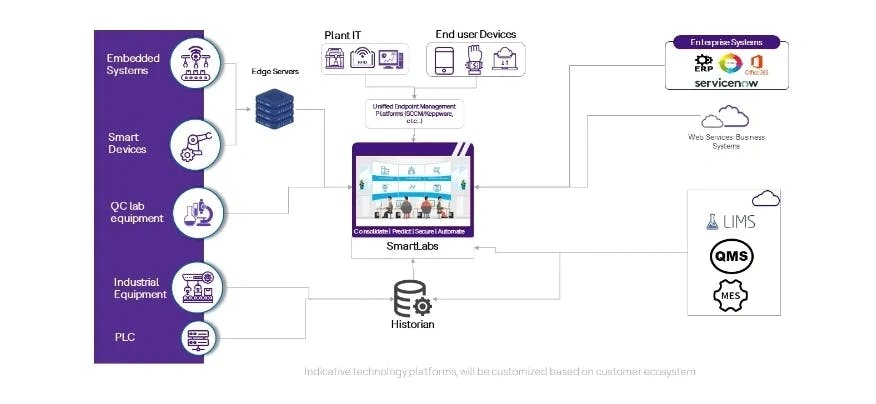Life Sciences, Pharmaceutical (pharma) and MedTech industries are undergoing a digital transformation that requires the convergence of information technology (IT) and operational technology (OT). IT refers to the systems and applications supporting business functions, such as enterprise resource planning, customer relationship management and data analytics. OT refers to the systems and devices that control the physical processes, such as sensors, actuators and machines. This fusion promises to offer a wealth of benefits, including enhanced operational efficiency, real-time data-driven decision-making and improved product quality, efficiency, quality, compliance and innovation. However, successfully integrating IT and OT systems in these critical sectors is challenging.
Challenges of IT, OT integration in Pharma and MedTech
An IT and OT integration is not a simple task for life sciences — organizations face several challenges and barriers, including:
- Siloed operations and cultures: IT and OT have different cultures, mindsets and objectives. IT focuses on standardization, scalability and security, while OT focuses on reliability, availability and safety. IT and OT teams often have distinct backgrounds, perspectives and responsibilities, leading to communication gaps and siloed operations. They may also have different reporting structures, performance metrics and incentives. These differences can create silos, conflicts and mistrust between the two domains, as well as make it difficult to align IT and OT strategies to ensure a cohesive approach to integration.
- Technical complexity: IT and OT have different architectures, protocols and technologies. IT systems are usually based on cloud, web and mobile platforms, while OT systems are based on legacy, proprietary and embedded platforms. IT and OT may also have different data formats, quality and frequency. These differences can create interoperability, compatibility and integration issues between the two domains.
- Regulatory compliance: These industries are highly regulated and must comply with strict standards and guidelines, such as Good Manufacturing Practice (GMP), Good Clinical Practice (GCP) and Good Laboratory Practice (GLP). An IT and OT integration can introduce new risks and vulnerabilities that may compromise the compliance and auditability of the products and processes. The IT and OT integration may also require changes in validation and verification procedures, documentation and training.
- Cybersecurity threats: An IT and OT integration can increase exposure and attack the surface of systems and devices. IT systems are usually connected to the Internet and vulnerable to external cyberattacks, such as malware, ransomware and phishing. OT systems are usually isolated and vulnerable to internal cyberattacks, such as sabotage, espionage and theft. The IT and OT integration can create new entry points and pathways for cyberattacks that may compromise the confidentiality, integrity and availability of data and operations.
This is particularly critical in the pharma and MedTech industries, where sensitive data and processes are involved in producing life-saving drugs and medical devices.
- Data standards and interoperability: Legacy OT systems often operate on proprietary protocols, data formats and communication methods, making it challenging to integrate them seamlessly with IT systems that rely on standardized interfaces and open protocols. Standardization of these systems is essential to ensure seamless integration. This lack of interoperability can hinder data exchange and analysis, hindering operational efficiency and decision-making.
- Legacy systems: Many organizations still rely on legacy systems incompatible with modern IT and OT systems. Upgrading these systems can be a time-consuming and expensive process.
- Resistance to change: Integrating IT and OT systems requires changes to existing processes and workflows, which can be met with resistance from employees. Organizations must provide adequate training and support to help employees adapt to the changes. A comprehensive change management plan is essential to address these concerns and ensure a smooth integration.
Overcoming challenges and achieving success
Organizations that successfully integrate IT and OT systems in the pharma and MedTech industries can expect numerous benefits, including:
- Enhanced operational efficiency: Real-time data insights from OT systems can inform IT-based decision-making, leading to optimized resource allocation, reduced downtime and improved production processes.
- Data-driven decision-making: By combining data from IT and OT systems, organizations can gain significant insights into their operations, enabling them to make informed decisions that enhance patient outcomes and product quality.
- Improved patient outcomes: Real-time monitoring and data analysis from connected devices can enable personalized treatment plans, improved diagnosis and enhanced patient care.
- Strengthened compliance: An IT and OT integration can facilitate compliance with regulatory requirements, such as GMP, by improving data integrity, traceability and process validation.

Strategies for success
GMP is not a blocker but an important aspect of life sciences manufacturing industries to ensure the quality and safety of products. Organizations must guarantee that their integrated systems comply with all relevant regulations, including GMP guidelines. To overcome the challenges of the IT and OT integration and achieve the desired benefits, organizations should adopt a comprehensive approach that includes:
- Develop comprehensive plan: Organizations must develop a comprehensive plan that outlines the goals, objectives and timelines for integrating IT and OT systems, and then align them with the overall business strategy and objectives. The plan should also identify the resources required and potential risks and challenges. This will provide a roadmap for decision-making and resource allocation.
- Ensure regulatory compliance: Organizations must plan to conduct a thorough risk assessment to identify potential cybersecurity, operational and regulatory threats associated with the IT and OT integration. Develop appropriate mitigation strategies to address these risks and check the safety and stability of critical systems.
- Standardize IT and OT systems and interoperability: Standardization of IT and OT systems is essential to ensure seamless integration. Organizations must guarantee that their systems use the same protocols, data formats and communication methods. The implementation of standardized data formats and protocols will facilitate seamless data exchange between IT and OT systems. This will enhance data consistency, accessibility and analysis capabilities.
- Cross-functional collaboration: Establish cross-functional teams with representation from IT, OT and business stakeholders. This collaboration will foster a shared understanding of challenges and facilitate the development of integrated solutions.
- Comprehensive change management: Develop a comprehensive change management plan that addresses communication, training and support needs. This plan will help minimize disruptions and ensure user adoption of the new systems.
- Embrace emerging technologies: Leverage emerging technologies, such as industrial IoT, edge computing, secure remote access and cybersecurity hardening, to address challenges and enhance integration capabilities.
We recently built an innovation lab at a client site to showcase some of the technologies to the lab community and allow them to try, use and test them. These have not only helped measure the value of these technologies but facilitated their adoption as well. The client got an unexpected bonus from these innovation labs, as employees were excited to work in the office, reducing the need for home offices.
- Confirm data security: The integration of IT and OT systems can create new security vulnerabilities that can be exploited by cybercriminals. Organizations must take appropriate measures to secure their systems and data.
- Upgrade legacy systems: Upgrading legacy systems can be time-consuming and expensive, but ensuring seamless integration is essential.
- Provide adequate training and support: Integrating IT and OT systems requires changes to existing processes and workflows, which can be met with resistance from employees. Organizations must provide adequate training and support to help employees adapt to the changes.
- Seek expert guidance: Engage experienced IT and OT integration consultants to provide guidance, expertise and support throughout the integration process. Their knowledge and experience can help organizations overcome challenges and achieve successful implementations.
HCLTech has abundant experience in IIoT, IT and OT convergence and cybersecurity.
We have completed several successful IT and OT integrations by using our Smart Intelligent Operations for Regulated Environments (SIO4RE) solution. The system integrates IT and OT systems to enable real-time monitoring and control of manufacturing processes, resulting in improved efficiency, quality and safety.

Image 2: SIO4RE architecture diagram
In conclusion, integrating IT and OT operations in pharma and MedTech industries is a challenging but necessary process. By addressing the challenges mentioned, organizations can achieve greater efficiency, productivity and innovation. Organizations must develop a comprehensive plan, standardize IT and OT systems, ensure data security, upgrade legacy systems, provide adequate training and support and ensure regulatory compliance, including GMP guidelines.
Many companies have chosen HCLTech for their IT and OT integrations to improve efficiency, reduce costs, gain a deeper understanding of their operations, make better decisions and deliver better products and services to improve patient outcomes.

